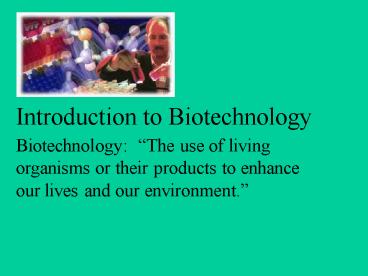Introduction to Biotechnology - PowerPoint PPT Presentation
1 / 21
Title:
Introduction to Biotechnology
Description:
modified bacteria that secrete enzymes to help dissolve oil spills in ... cloning ... or resurrecting extinct species using cloning techniques. ... – PowerPoint PPT presentation
Number of Views:7637
Avg rating:3.0/5.0
Title: Introduction to Biotechnology
1
Introduction to Biotechnology
Biotechnology The use of living organisms or
their products to enhance our lives and our
environment.
2
Biotechnology Produce traditional products in
clever, new ways Produce new products (drugs,
proteins) that didnt exist before Modify
genetics to produce organisms with new
recombinant traits.
3
- Produce traditional products in clever, new ways
- increase crop productivity, meat production,
and milk production - bacteria that produce insulin for treatment of
diabetes - modified bacteria that secrete enzymes to help
dissolve oil spills in marine habitats
The miracle of Genetic Engineering
4
Produce new products (drugs, proteins)that
didnt exist before -diagnostic tests to identify
genes for inherited diseases cystic fibrosis,
Huntingtons disease. -forensics assays for DNA
and body fluids -scientists hope to produce
individualized designer antibiotics that match
the individual persons unique requirements.
5
Modifying genetics to produceorganisms with new
recombinant traits. -plants with resistance to
disease and parasites. -replacing a defective
gene in a plant, animal or human -in vitro
fertilization, cloning -preservation of species
by freezing gametes or embryos, or resurrecting
extinct species using cloning techniques.
6
Spider Silk From Goat Milk
7
Ancient Biotechnology50,000 years ago - at
least two different species of people began
to pass on cultural traditions. People could
imagine, share ideas, plan ahead, honor their
dead.They began to see the worldas something
that could bemanipulated. 10,000 years ago -
the traditions of agriculture and animal
husbandry began to develop. Wheat, rye,
barley Goats, sheep
8
Early Agriculture Even relatively primitive
peoples understood that selective breeding had
positive outcomes. -larger grain seeds ?
flour-selective breeding of goats and
eventually cattle to increase milk production
and meat content. Agrarian societies unknowingly
participated in genetic manipulation to make
useful products for humans.SELECTIVE BREEDING IS
BIOTECHNOLOGY
9
Modern Example of Selective Breeding
Selective Breeding of Kale (Brassica
oleracea) Cabbage Brussels Sprouts Cauliflower
Kohlrabi Kale
10
This is modern Kale. Its ancestor provided the
stock for the selective breeding of the other
subspecies.
11
The large terminal buds of the plant were
selected to produce cabbage.
12
Large lateral buds were selected to produce
Brussels Sprouts
13
Cauliflower was produced by selecting for large,
white flower stalks.
14
For broccoli, large stems and flower stalks were
both selected.
15
Kohlrabi was produced by selecting for short, fat
stems
16
And this is modern Kale. Remember, allof the
vegetables that you have seen are the SAME
SPECIES EACHPRODUCED BYSELECTIVE BREEDING
TAKING ADVANTAGE OF WILD TYPE GENES AND NATURAL
MUTATIONS.
17
- 2,500 years ago
- Egyptians, Romans, Sumarians traveled and
exchanged grape vines, rose plants, fig plants. - Romans traveled into Africa in search of
spices, herbs and new vegetables - Species were cross-bred, hybridized and carefully
selected for traits of better flavor, size, and
diseaseresistance.
18
Modern Preservation Efforts -1930s
PresentRussian and American scientists began
storing seeds of natural and hybrid plant
speciesConsultative Group on International
Agricultural Research (CGIAR) species
preservation and improvement of agricultural
methodsImportance of genetic diversity as a
world resource.
19
Use of Microorganisms Yeast bread, beer Sugar ?
CO2 CH3CH2OHBacteria cheese, yogurt,
antibioticsMolds cheeses Louis Pasteur
(1860s) clearly demonstrated that microbes are
responsible for fermentation (art becomes
science)
20
Classical Biotechnology 19th 20th
Century Fermentation became more
sophisticated-beers and wine-vinegar-acetone,
butanol (used for explosives)-antibiotic
production-steroid production-amino acid
synthesis by bacteria
21
History of Modern Genetics 1857 Gregor
Mendel1860 Johann Miesher isolated nuclei and
nuclein1882 - Walter Fleming observed the
division of chromosomes during mitosis1903
Walter Sutton observed independent assortment
of chromosomes during meiosis and reasoned that
these chromosomes must have carried the units of
inheritance described by Mendel.
Gregor Mendel































